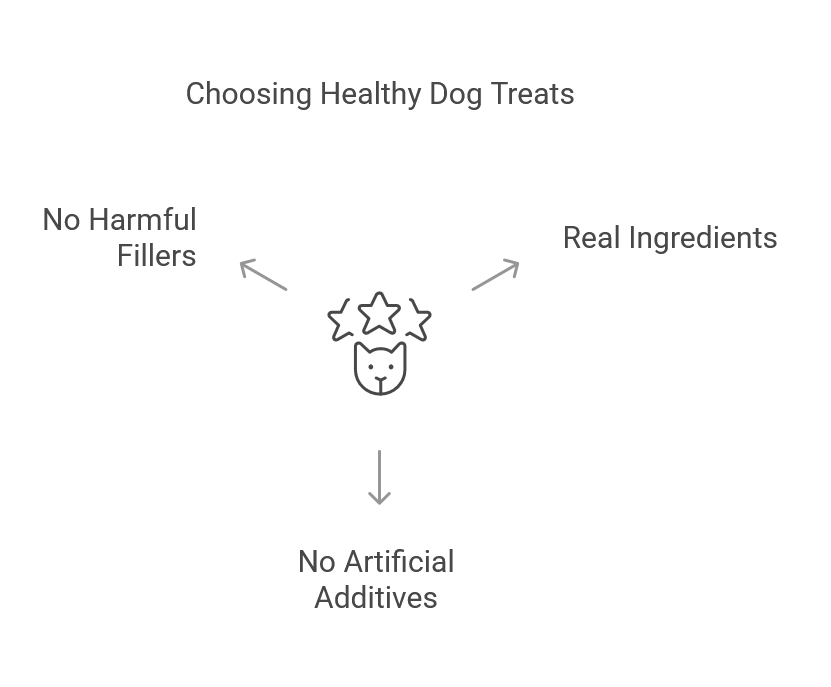Table of Contents
A Comprehensive Guide to Nutritious and Safe Treat Choices
Introduction
For many dog owners, treating their furry companions is an essential part of daily life. Whether it’s a reward for good behavior, a way to reinforce training, or simply an expression of love, treats play a significant role in human-canine relationships. However, not all treats are created equal. While some are packed with essential nutrients, others are loaded with artificial fillers, preservatives, and excess calories that can contribute to obesity and other health issues.
Choosing the healthiest treats for dogs isn’t just about picking what’s available at the pet store—it’s about understanding ingredients, nutritional value, and the specific needs of your dog. The healthiest treats for dogs can support everything from dental health to weight management and even provide therapeutic benefits.
With a growing market for specialized dog treats—including organic, plant-based, and functional varieties—pet owners have more options than ever. However, this variety also makes it challenging to determine which treats are truly beneficial. In this guide, we will explore what makes a treat healthy, the different types available, and how to choose the best options for your dog.
By the end of this article, you’ll have a thorough understanding of:
- What to look for in healthiest treats for dogs
- The best options for training, dental care, and nutritional support
- How to balance treat-giving with your dog’s overall diet
- Emerging trends in dog treats, including plant-based and CBD-infused options
Whether you’re a seasoned dog owner or new to pet parenting, this guide will help you make well-informed choices about the healthiest treats for dogs, ensuring your canine companion stays happy, healthy, and well-nourished.
1. What Makes a Treat Healthy?
Not all dog treats contribute to your pet’s well-being. Some are formulated with high-quality ingredients that provide essential nutrients, while others are filled with empty calories and artificial additives that may lead to long-term health issues. Understanding what makes a treat truly healthy is crucial in selecting the best option for your dog.
1.1 Minimal, High-Quality Ingredients
One of the most important factors in determining whether a treat is healthy is its ingredient list. The best healthiest treats for dogs contain minimal, recognizable, and high-quality ingredients, avoiding unnecessary fillers, artificial preservatives, and synthetic flavors.
- Look for treats that contain real, whole-food ingredients such as lean proteins, vegetables, and natural fiber sources.
- Avoid treats with artificial colors, preservatives, and added sugars.
- Steer clear of fillers like corn, wheat, and soy, which provide little nutritional value and can cause allergies in some dogs.

According to PetMD (source), dog treats should ideally be free from artificial additives and should prioritize natural, wholesome ingredients that support your pet’s overall health.
1.2 Nutritional Balance and Purpose
Different treats serve different purposes, and understanding these distinctions is key to making informed choices.
- Training Treats – These should be low in calories and small in size, making them suitable for frequent use during obedience training.
- Dental Treats – Designed to promote oral health by reducing plaque and tartar buildup. Many also contain breath-freshening ingredients.
- Functional Treats – These may contain added vitamins, omega-3 fatty acids, or probiotics to support skin, coat, and digestive health.
Veterinary sources, including The Vets (source), emphasize that healthiest treats for dogs should provide a nutritional benefit beyond just being an occasional indulgence.
1.3 Veterinary-Approved Treats & Portion Control
Even the healthiest treats should be given in moderation. Treats should make up no more than 10% of a dog’s daily caloric intake (source).
- Overfeeding treats, even healthy ones, can lead to obesity.
- Consulting a veterinarian ensures that treats align with a dog’s specific dietary needs, allergies, and existing health conditions.
- For dogs with medical conditions (e.g., diabetes, kidney disease), a veterinarian can recommend suitable treat options.
A lack of clear labeling on some commercial treats presents a challenge for pet owners trying to make informed choices (source). Always read labels carefully and choose treats with clearly stated nutritional information.
2. Types of Healthy Dog Treats
With an increasing number of pet treat options available, it’s important to distinguish which treats offer the most health benefits. Below are some of the healthiest treats for dogs, categorized based on their purpose and nutritional content.
2.1 Training Treats: Small, Low-Calorie Rewards
Training treats should be bite-sized, easy to digest, and low in calories so they can be given frequently without impacting a dog’s weight.
✅ Best Options:
- Pet Botanics Training Rewards – Only 3 calories per treat, made without corn, soy, or preservatives.
- Merrick Power Bites – Contain omega-3 and omega-6 fatty acids for skin and coat health.
2.2 Dental Chews for Oral Health
Dental health is a crucial aspect of overall wellness, and dental chews help reduce tartar buildup and freshen breath.
✅ Best Option:
- Virbac Tartar Control Dog Chews – Made from plant-based ingredients, contain prebiotics for digestion.
2.3 Whole-Food & Natural Treats
Natural treats provide fiber, vitamins, and essential nutrients without artificial additives.
✅ Best Options:
- Pumpkin & Squash (source) – High in fiber, supports digestion.
- Carrots & Apples – Low-calorie, crunchy, and packed with vitamins.
2.4 Plant-Based & Alternative Protein Treats
Recent research indicates that dogs can thrive on nutritionally complete plant-based diets (source).
- Pea protein-based treats have been found to help overweight dogs achieve a healthier weight.
- Meat-based treats dominate the market due to perceived naturalness, but high-quality plant-based alternatives exist.

2.5 CBD and Functional Treats
CBD dog treats are gaining popularity for their potential benefits in pain relief, anxiety management, and inflammation reduction.
✅ Consideration:
- While some owners report benefits, research is still ongoing, and veterinary guidance is recommended before use (source).
3. Key Considerations When Choosing Dog Treats
Selecting the healthiest treats for dogs requires more than just picking a product labeled as “natural” or “organic.” There are several key factors that dog owners should consider, including ingredient transparency, portion control, and understanding market trends in pet treats. Here’s what to keep in mind when making the best choice for your canine companion.
3.1 Moderation: The Key to Healthy Treating
Even when treats are made from high-quality ingredients, overfeeding can lead to serious health issues. Obesity in dogs has been linked to increased risks of diabetes, joint problems, and heart disease (source).
- The 10% Rule: Treats should not make up more than 10% of a dog’s daily caloric intake to prevent excess weight gain.
- Portion Sizes Matter: Even healthiest treats for dogs can add up quickly—especially for small breeds. Opt for low-calorie options for frequent treating.
A common mistake dog owners make is using large treats as frequent rewards, especially during training. Instead, breaking treats into smaller pieces or choosing naturally small options like Pet Botanics Training Rewards (source) can ensure that a dog remains within a healthy caloric range while still receiving positive reinforcement.
3.2 The Challenge of Misleading Labels
One of the biggest issues in the pet treat industry is the lack of clear nutritional information on product labels. Many treats marketed as “healthy” may still contain:
- High amounts of carbohydrates and fillers (corn, wheat, soy)
- Artificial preservatives (BHA, BHT, ethoxyquin)
- Unnecessary sugars and artificial flavors
A report from Frontiers in Animal Science (source) highlights that labeling discrepancies make it difficult for dog owners to assess nutritional value accurately. For this reason, reading ingredient lists carefully is crucial. The best rule of thumb? The shorter the ingredient list, the better the treat.
3.3 Meat-Based vs. Plant-Based Treats: Market Trends and Health Considerations
Meat-based treats have long dominated the pet food market, primarily due to the perception that dogs require meat for optimal health. However, research suggests that nutritionally complete plant-based diets can be just as beneficial for dogs (source).
- Plant-Based Treats & Weight Management: A study found that overweight dogs fed a pea protein-based diet for a year achieved healthier body weights while maintaining overall wellness.
- Sustainability & Ethical Considerations: With increasing concerns about sustainability, plant-based and insect-based dog treats are emerging as viable alternatives.
While many dog owners still prefer meat-based treats due to their perceived “naturalness,” the growing body of research on plant-based nutrition provides dog owners with more options than ever before (source).
3.4 The Rising Popularity of CBD Treats
In recent years, CBD-infused dog treats have gained traction, with many owners turning to them as a potential solution for pain relief, anxiety, and inflammation. According to PubMed (source), CBD may help with conditions such as arthritis pain, seizures, and stress, though long-term effects and optimal dosages are still being researched.
- Pros: Potential benefits in reducing anxiety, improving joint health, and managing pain.
- Cons: Limited regulation, potential quality inconsistencies, and a lack of long-term studies.
If considering CBD treats, consulting a veterinarian first is essential to ensure safety and appropriate dosing.
4. The Role of Treats in a Dog’s Overall Health
While treats are often viewed as simple indulgences, they can serve an essential role in a dog’s overall well-being. When chosen wisely, the healthiest treats for dogs contribute to nutritional support, weight management, dental care, and emotional well-being.
4.1 Strengthening the Human-Canine Bond
Treats are more than just snacks—they are tools for reinforcing positive behavior and building trust. Studies suggest that the act of giving treats strengthens the emotional connection between pet owners and their dogs, contributing to better training outcomes and overall companionship satisfaction (source).
Whether using treats for basic obedience training, behavior correction, or socialization, they should always be incorporated into a well-structured reinforcement strategy rather than given indiscriminately.
4.2 Nutritional Support Beyond Regular Meals
Certain treats provide essential vitamins, minerals, and functional nutrients that may not be adequately supplied by a dog’s main diet.
- Omega-3 and Omega-6 Fatty Acids – Found in treats like Merrick Power Bites (source), these help maintain a healthy coat and reduce inflammation.
- Fiber & Digestive Health – Treats containing pumpkin, squash, and sweet potatoes provide natural fiber that aids digestion and regulates bowel movements (source).
4.3 Dental Health & Preventing Periodontal Disease
Many veterinarians emphasize the importance of dental chews as part of a preventive oral care routine. According to The Vets (source), dental treats can significantly reduce tartar buildup and slow the progression of periodontal disease.
- Best Dental Treats: Virbac Tartar Control Dog Chews (source)
- Additional Oral Health Benefits: Some dental chews contain breath-freshening ingredients like parsley and chlorophyll.
While dental treats are beneficial, they should complement—not replace—regular tooth brushing and professional dental cleanings.

4.4 Weight Management & Obesity Prevention
Overweight and obese dogs are at higher risk for diabetes, arthritis, and cardiovascular disease. Treats can either contribute to or help manage weight depending on the choices made by pet owners.
- Low-Calorie Options for Weight Control:
- Pet Botanics Training Rewards – Only 3 calories per treat (source).
- Vegetable-Based Treats – Carrots, celery, and green beans are excellent low-calorie alternatives.
Research from Sustainable Pet Food Association (source) found that dogs on a plant-based diet experienced significant weight reduction, highlighting the potential role of alternative treats in weight control.
Conclusion
Choosing the healthiest treats for dogs is about more than just picking a snack your pet enjoys—it’s about ensuring that every treat provides nutritional value, supports overall health, and aligns with your dog’s specific dietary needs. While treats play a role in bonding and training, they should be given in moderation and always selected with ingredient quality and health benefits in mind.
From training treats to dental chews, plant-based alternatives, and functional treats infused with omega fatty acids, there are many options that go beyond mere indulgence. By selecting high-quality, natural treats and being mindful of portion control, pet owners can help their dogs maintain a healthy weight, strong teeth, and a well-balanced diet.
Additionally, understanding market trends and label discrepancies is crucial in making informed choices. With the rise of plant-based diets, CBD treats, and sustainable pet products, dog owners today have more options than ever. However, consulting with a veterinarian remains essential, particularly when introducing new treat types or managing specific health conditions like allergies or obesity.
At the end of the day, the best treats are those that enhance a dog’s life rather than simply satisfying a craving. By prioritizing nutrition, moderation, and purpose, you can ensure that treating your dog is both a joyful and beneficial experience—for you and your furry companion alike.
FAQs
1. What are the healthiest treats for dogs?
The healthiest treats for dogs are low in calories, made from whole-food ingredients, and free from artificial additives and fillers. Examples include:
- Training Treats: Pet Botanics Training Rewards (low-calorie, free from artificial preservatives)
- Dental Chews: Virbac Tartar Control Dog Chews (help reduce plaque buildup)
- Natural Whole-Food Treats: Pumpkin, carrots, apples, and squash (source)
- Functional Treats: Treats enriched with omega-3 fatty acids for skin and coat health, such as Merrick Power Bites.
2. How often should I give my dog treats?
Treats should not make up more than 10% of your dog’s daily caloric intake (source). The frequency depends on the type of treat:
- Training treats: Given frequently but in small amounts.
- Dental treats: Typically given once per day to support oral health.
- Nutritional treats: Used sparingly to supplement a dog’s diet.
3. Are plant-based treats safe and healthy for dogs?
Yes, dogs can thrive on a nutritionally complete plant-based diet, provided it meets their essential dietary requirements (source). Many plant-based treats are:
- High in fiber (pumpkin, carrots)
- Protein-rich (pea protein-based treats)
- Beneficial for weight management (found to help overweight dogs maintain a healthier weight)
However, always consult your veterinarian before switching to a plant-based diet, especially for dogs with specific health needs.
4. What should I avoid when buying dog treats?
Avoid treats containing:
❌ Artificial preservatives like BHA, BHT, and ethoxyquin.
❌ High levels of sugar or corn syrup.
❌ Fillers like wheat, corn, and soy, which provide little nutritional value.
❌ Artificial colors and flavors, which can contribute to allergies or digestive upset.
Instead, opt for treats with short ingredient lists featuring real, recognizable ingredients (source).
5. Can I make homemade treats for my dog?
Yes! Many dog owners prefer homemade treats to ensure ingredient quality and avoid preservatives. Some easy and healthy DIY treat ideas include:
- Frozen banana & peanut butter bites (using unsweetened peanut butter)
- Baked sweet potato chews (a natural, nutrient-dense alternative to rawhide)
- Homemade pumpkin & oat biscuits (great for digestion)
Always ensure ingredients are safe for dogs—for example, avoid using xylitol, chocolate, onions, or excessive salt, as these are toxic to dogs.
6. Do dental chews really help with oral health?
Yes, dental chews can reduce plaque and tartar buildup, but they should not replace regular brushing (source). The best approach to oral hygiene includes:
- Daily brushing with dog-safe toothpaste
- Veterinary dental cleanings
- Dental chews as a supplement (such as Virbac Tartar Control Chews)
7. Are CBD treats safe for dogs?
CBD dog treats are growing in popularity for their potential benefits in reducing anxiety, pain, and inflammation (source). However:
- Research on long-term effects is still ongoing.
- Doses should be carefully monitored, as excessive amounts could lead to side effects.
- Always consult your vet before introducing CBD treats to your dog’s diet.
8. What are the best treats for dogs with allergies?
Dogs with food allergies or sensitivities may benefit from limited-ingredient treats made without common allergens like chicken, beef, dairy, wheat, or soy.
Recommended options include:
✅ Hypoallergenic Treats: Novel protein sources like duck, venison, or fish.
✅ Single-Ingredient Treats: Freeze-dried liver, dehydrated sweet potato, or pure pumpkin.
✅ Grain-Free Options: Treats made with chickpea flour, coconut, or other alternative grains.
Check product labels carefully and consult your veterinarian if your dog has known food allergies.




